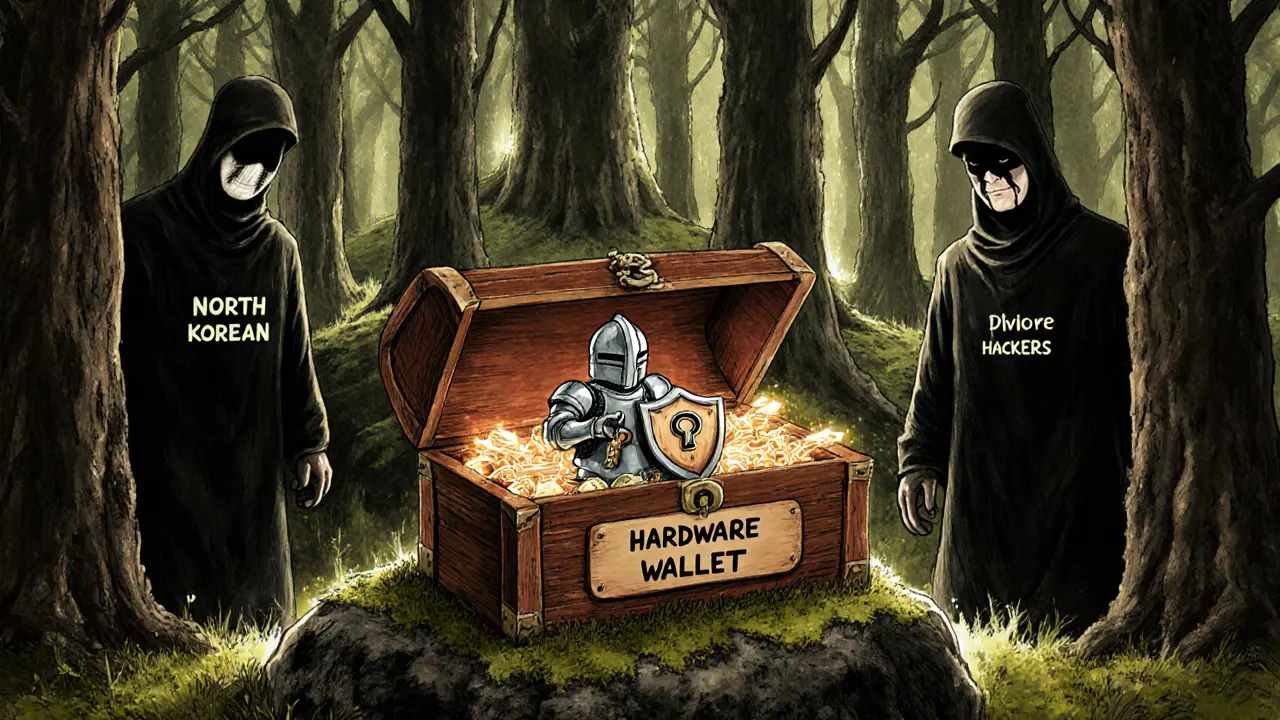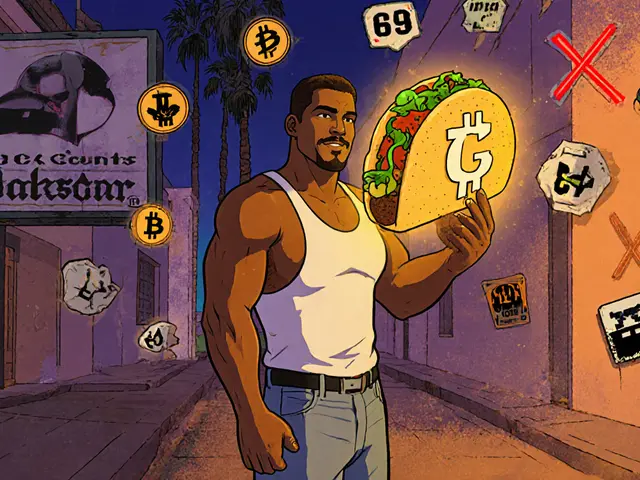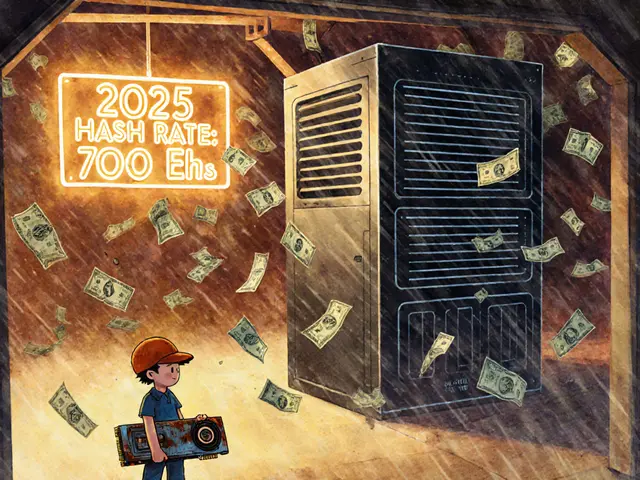Crypto Investment Risk Assessment Tool
Assess Your Crypto Investment Suitability
This tool helps you determine if cryptocurrency investment aligns with your financial situation based on factors like risk tolerance, investment horizon, and financial stability.
Bitcoin hit $100,000 in late 2024, and by mid-2025, the whole cryptocurrency market is worth over $3.2 trillion. That’s not a flash in the pan. Major banks, investment firms, and even payment giants like Mastercard are building real infrastructure around it. But here’s the thing: if you’re thinking about jumping in, you need to know what you’re getting into. It’s not just about buying and hoping it goes up. Cryptocurrency offers real advantages - faster payments, new ways to earn, protection against inflation - but it also comes with serious risks you can’t ignore.
Why People Are Turning to Cryptocurrency
One of the biggest draws is speed and cost. Sending money across borders used to mean waiting days and paying 5-7% in fees. With crypto, you can send $5,000 to someone in another country in under ten minutes, and the fee might be less than $2. That’s why companies like JPMorgan’s Kinexys platform now process over $2 billion in crypto transactions every month. It’s not just for tech geeks anymore - it’s for businesses trying to cut costs and move money faster. Another reason? Diversification. Traditional investments like stocks and bonds often move together. When the stock market drops, your portfolio takes a hit. Cryptocurrency, on the other hand, has a correlation of just 0.37 with the S&P 500 in 2025. That means it doesn’t always follow the same pattern. For investors looking to spread risk, adding a small amount of crypto can actually make their whole portfolio more stable over time. Then there’s inflation. When prices rise and your savings lose value, gold has been the go-to hedge. But Bitcoin has shown a 0.68 correlation to inflation metrics during the high-inflation years of 2024 and 2025. That’s stronger than many traditional assets. People aren’t just buying Bitcoin because it’s trendy - they’re buying it because they see it as a store of value that can’t be printed by central banks.The High Returns - And the High Stakes
Let’s be honest. The biggest lure is the potential for huge returns. Bitcoin returned 76.4% in 2024, while the S&P 500 returned just 10.2%. That kind of gap pulls in people looking to grow their money fast. Some retail investors made life-changing gains during the 2024 bull run. But here’s what no one tells you: those same people lost 60% of their portfolio in July 2025 when a wave of liquid staking protocols automatically sold off their positions. It wasn’t a market crash - it was a system failure built into the design. Volatility isn’t a bug - it’s a feature. Bitcoin’s annual volatility in 2025 was 44.1%. Compare that to gold at 14.2% or the S&P 500 at 15%. That kind of swing means you could wake up one day with your investment up 20%, and the next day down 15%. If you can’t sleep at night thinking about it, crypto might not be for you.Security: Better Than You Think - But Still Dangerous
The idea that crypto is unsecure is outdated. Institutions now use multi-signature wallets requiring at least three out of five keys to move funds. They store private keys in hardware security modules (HSMs), locked in secure vaults. These aren’t random people with passwords written on sticky notes. These are banks and hedge funds with billion-dollar systems. But the weak point isn’t your wallet - it’s the code. Smart contracts, the self-executing programs that run DeFi platforms, have flaws. In H1 2025, hackers stole $1.5 billion from ByBit alone. And it’s not just random hackers anymore. North Korean state-backed groups are running organized cybercrime operations targeting crypto exchanges. Chainalysis reports that $3 billion was stolen in the first half of 2025, mostly through phishing, exchange hacks, and laundering services that make stolen crypto look clean. Retail users are especially vulnerable. Trustpilot reviews show Coinbase users complaining about withdrawal delays during market spikes. Binance users report account freezes with little explanation. If you’re not using two-factor authentication, a hardware wallet, and avoiding sketchy DeFi apps, you’re playing Russian roulette.
It’s Not Ready for Everyday Use
You hear people say, “Why not pay for coffee with Bitcoin?” The answer: because it’s too volatile. Only 12% of merchants who accept crypto can keep their prices stable. If your latte costs 0.002 BTC today, it might cost 0.0025 BTC tomorrow. That’s not practical. Most people who use crypto for purchases are either tech-savvy early adopters or paying for illegal goods. That’s why the real adoption is happening behind the scenes. Mastercard’s Multi-Token Network processes 50,000 transactions per second. That’s faster than Visa. But you don’t see it because it’s used to settle payments between banks, not at your local grocery store. The future of crypto isn’t replacing cash - it’s replacing the old banking rails that connect them.Regulation Is Catching Up - Fast
In 2025, the rules are changing fast. The U.S. Securities and Exchange Commission finalized SAB 122, which clarifies how digital assets must be held by financial institutions. The European Union’s MiCAR regulation requires crypto platforms to disclose 189 different pieces of information. Hong Kong now licenses exchanges like banks. Australia is moving toward similar rules. This isn’t bad news. It means the industry is growing up. But it also means more paperwork, higher compliance costs, and fewer shady platforms. In fact, 47% of crypto businesses say their compliance costs jumped 25-40% in the last year. That’s why smaller, unregulated exchanges are disappearing - and why big players like Coinbase and Binance are spending millions to stay legal.
Who Should Avoid Cryptocurrency?
If you need your money to be safe and predictable, don’t put it in crypto. If you’re saving for a house in five years, or your child’s education, crypto is too risky. The same goes if you don’t understand how private keys work, or if you’ve ever clicked a link from a random Twitter DM. Also, avoid it if you’re chasing quick riches. The people who make real money in crypto aren’t day traders. They’re the ones who bought Bitcoin in 2017, held through the 2018 crash, ignored the 2021 hype, and kept holding through 2022 and 2023. They didn’t chase pumps. They understood the tech and stayed calm.Who Might Benefit?
If you’re an investor with a long-term horizon (5+ years), and you’re comfortable with volatility, crypto can be a smart addition to a diversified portfolio. Start small - 1-5% of your total assets. Use a reputable exchange like Coinbase or Kraken. Store your holdings in a hardware wallet like Ledger or Trezor. Don’t touch it for years. Let it ride the cycles. If you’re a freelancer or small business owner who deals with international clients, crypto can save you money on fees and delays. You can get paid in Bitcoin or Ethereum, convert it to AUD via a regulated exchange, and deposit it into your bank account. It’s faster, cheaper, and more transparent than PayPal or Western Union. And if you’re curious about the tech - learn it. Spend 40-60 hours learning how wallets work, how transactions are verified, what gas fees are, and how DeFi lending works. There are free courses from Coinbase and Ethereum Foundation. Don’t just watch YouTube influencers. Understand the system.The Bottom Line
Cryptocurrency isn’t magic. It’s not a guaranteed path to wealth. It’s not a scam either. It’s a new kind of financial tool - powerful, unpredictable, and still evolving. It gives you control over your money in ways banks never could. But it also puts all the responsibility on you. The people who succeed aren’t the ones who bought at the top. They’re the ones who stayed informed, stayed cautious, and never bet more than they could afford to lose. In 2025, crypto isn’t for everyone. But for those who understand its strengths and weaknesses? It’s one of the most interesting financial developments in decades.Is cryptocurrency a good investment in 2025?
Cryptocurrency can be a good investment if you’re investing for the long term (5+ years), understand the risks, and only use money you can afford to lose. Bitcoin and Ethereum have shown strong growth over time, but they’re extremely volatile. Institutional adoption is growing, with 67% of major investors now holding crypto, mostly for portfolio diversification. Don’t treat it like a get-rich-quick scheme.
Can I lose all my money in crypto?
Yes, you can. If you invest in low-quality tokens, use unsecured wallets, fall for scams, or get caught in a liquidation event (like the July 2025 crash), you can lose everything. Even Bitcoin, the most established crypto, dropped over 40% in a single week in 2025. Never invest more than you’re willing to lose completely.
Is crypto legal in Australia?
Yes, cryptocurrency is legal in Australia. You can buy, sell, and hold crypto without restrictions. However, the Australian Taxation Office (ATO) treats it as property, not currency. That means you owe capital gains tax when you sell or trade it for profit. Exchanges operating in Australia must also comply with anti-money laundering laws.
How do I store cryptocurrency safely?
For small amounts, use a reputable exchange wallet like Coinbase or Kraken with two-factor authentication. For larger holdings, use a hardware wallet like Ledger Nano X or Trezor Model T. These devices store your private keys offline, making them immune to online hacks. Never share your recovery phrase. Write it down on paper and keep it in a fireproof safe. Never store it digitally.
What’s the difference between Bitcoin and Ethereum?
Bitcoin is primarily digital money - a store of value and peer-to-peer payment system. Ethereum is a programmable blockchain that lets developers build apps, smart contracts, and decentralized finance (DeFi) platforms. Bitcoin uses proof-of-work; Ethereum uses proof-of-stake, making it faster and more energy-efficient. Bitcoin’s market cap is larger, but Ethereum has more real-world applications beyond just being money.
Are crypto taxes complicated in Australia?
They can be, if you’re active. Every time you sell, trade, or use crypto to buy something, it’s a taxable event. You need to track the AUD value at the time of each transaction. The ATO has tools to detect crypto activity from exchanges. Use software like Koinly or CryptoTaxCalculator to automate tracking. If you just buy and hold, you only pay tax when you sell. Keep records for at least five years.
Can I use crypto to pay bills or buy groceries?
Very few places accept crypto directly for everyday purchases. Some online retailers and local businesses might, but most won’t because prices fluctuate too much. The easier way is to use a crypto debit card (like Crypto.com or BitPay) that automatically converts your crypto to AUD at checkout. But even then, you’re still exposed to volatility at the moment of conversion.
What’s the future of cryptocurrency?
The future isn’t about replacing cash. It’s about replacing the old financial infrastructure. Blockchain is already being used by banks for faster settlements, by governments for digital IDs, and by companies for supply chain tracking. Bitcoin may become a global reserve asset. Ethereum will power more decentralized apps. But it will happen slowly, with regulation, security upgrades, and real-world integration - not through hype or memes.






Louise Watson
November 7, 2025 AT 20:11Crypto isn't magic. It's math. And math doesn't care if you believe in it.
Benjamin Jackson
November 9, 2025 AT 07:31I’ve held BTC since 2021 and I still don’t check the price every hour. It’s weird how the more you learn, the less you feel the need to panic. Let it breathe.
Liam Workman
November 9, 2025 AT 21:31People treat crypto like a slot machine, but it’s more like planting a tree. You don’t dig it up every week to see if the roots are growing. 🌱 You water it, you wait, you trust the process. The real win isn’t the price-it’s the freedom you gain when you stop depending on banks to hold your money.
Meagan Wristen
November 11, 2025 AT 19:00I’m from the Philippines and my cousin sends me money via USDT every month. It takes 7 minutes and costs less than $0.50. My bank used to charge $35 and take 5 days. This isn’t speculation-it’s survival for so many people.
Noah Roelofsn
November 11, 2025 AT 19:08Let’s be real-the real innovation isn’t Bitcoin. It’s the settlement layer. Banks are quietly using blockchain to settle cross-border trades in seconds, not days. You don’t see it because it’s behind the curtain. The retail side? That’s just the flashy demo. The real revolution is in the backend, where nobody’s posting memes about it.
Abelard Rocker
November 13, 2025 AT 13:19Oh wow, so now we’re supposed to be impressed that big banks are ‘adapting’? 🤡 They’re not adopting crypto-they’re co-opting it. They’re building their own walled gardens with permissioned blockchains, locking out the decentralized dream, and calling it ‘innovation.’ The whole thing’s a corporate power grab wrapped in blockchain glitter. They want control, not freedom. And they’ll kill DeFi the moment it threatens their fee farms. Don’t be fooled. This isn’t progress-it’s colonization.
Meanwhile, you’re out here buying ETH because some influencer said ‘to the moon.’ Meanwhile, the real power players are already in, and they’re not holding for ‘long-term gains.’ They’re front-running your trades, manipulating liquidity pools, and cashing out before the next ‘bull run’ turns into a bloodbath. The system is rigged. The only thing more dangerous than losing your crypto? Thinking you’re playing on equal footing.
And don’t even get me started on ‘regulation.’ MiCAR? SAB 122? That’s not protection-it’s a death sentence for small players. Compliance costs are crushing startups while Coinbase and Binance laugh all the way to the SEC’s office. They’re not here to protect you. They’re here to make sure you can’t compete.
The only people who win? The ones who built the system. Everyone else? Just noise in the machine.
Hope Aubrey
November 13, 2025 AT 20:04Ugh. Another ‘crypto is the future’ lecture. I live in the U.S. and I pay my taxes with cash. Why? Because I don’t trust some algorithm to hold my life savings. And no, ‘hardware wallets’ don’t fix the fact that some 19-year-old in a basement can drain your funds with a phishing link. I’m not a Luddite-I just don’t want my retirement on a blockchain that can be hacked by a Discord bot.
Also, ‘store of value’? Bitcoin dropped 40% in a week. Gold didn’t. Your ‘digital gold’ is just digital.
Ryan McCarthy
November 14, 2025 AT 16:31Hope you’re right about regulation being good. I just hope it doesn’t kill the innovation. I’ve seen too many brilliant devs leave the space because compliance is too heavy. We need guardrails, not cages.
andrew seeby
November 16, 2025 AT 09:35bro i just use binance and forget about it 😎
Sierra Rustami
November 16, 2025 AT 12:29Why are we even talking about this? America should ban crypto. It’s a foreign threat. China’s behind most of the mining. Russia’s laundering through it. And now we’re letting our kids gamble with their savings? No. Just no.
Becca Robins
November 17, 2025 AT 22:11i dont get why ppl are so scared of crypto like its a ghost or sumthin. its just money on the internet lol. i bought doge in 2021 and it went up then down then up again. i still have it. its chill. 🐶💸
Alexa Huffman
November 19, 2025 AT 15:41There’s a crucial distinction between ‘crypto as a tool’ and ‘crypto as a speculative asset.’ The former enables financial sovereignty; the latter fuels bubbles. Most people confuse the two. The solution isn’t to reject crypto-it’s to educate users on the difference.
Steven Lam
November 19, 2025 AT 22:25Stop acting like you're some genius for holding BTC. Everyone who bought in 2019 is rich now. That doesn't mean crypto is smart. It means you got lucky. And now you're acting like you earned it. Newsflash: you didn't. You just didn't sell.
Finn McGinty
November 21, 2025 AT 12:17There is a fundamental misunderstanding here: cryptocurrency does not exist to replace banks. It exists to replace the illusion of trust. Banks don’t hold your money-they lend it out. Crypto lets you hold it yourself. That’s not speculation. That’s sovereignty. The volatility? That’s the price of liberation. You want stability? Go back to the system that crashed in 2008 and again in 2020. The only thing more dangerous than crypto’s risk is the false security of legacy finance.
And yes, the hacks are real. But so are the bank heists. So are the fraudulent mortgages. So is the hidden fee structure. Crypto’s transparency is its greatest strength. You can see every transaction. You can audit the code. You can verify the supply. Banks? They operate in black boxes with auditors paid by the same institutions they’re supposed to police.
Regulation isn’t the savior-it’s the final stage of institutional capture. The moment a government licenses a crypto exchange, it becomes a bank with better UI. The true decentralization dies not from hackers, but from compliance officers.
So yes, buy Bitcoin. But don’t buy it because you think it’ll make you rich. Buy it because you want to own your money. Not your bank. Not your government. You.
And if you’re still worried about volatility? That’s not a flaw. It’s a feature. It’s the market telling you: this isn’t a game for the timid.
Leo Lanham
November 22, 2025 AT 05:32Anyone who says crypto is for long-term investors is just trying to sell you a dream. The only people making money are the ones who pump and dump. Everyone else is just the sucker at the end of the line.